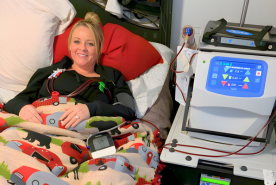Hemodialysis catheters help clean your blood when kidneys fail. Learn how to care for your catheter to prevent infections and keep blood flowing well.
Hemodialysis is a treatment used when your kidneys fail (Stage 5 Kidney Disease) and can no longer clean your blood and remove extra fluid from your body. A hemodialysis access or vascular access is a way to reach your blood for hemodialysis.
If you receive hemodialysis, your access is one of the following:
- An AV fistula made by joining an artery and vein in your arm
- An AV graft made by using a soft tube to join an artery and vein in your arm
- A catheter, a soft tube that is placed in a large vein, usually in your neck
The National Kidney Foundation (NKF) recommends the AV (arteriovenous) fistula as the preferred choice for a permanent vascular access. The AV graft is the next preferred choice for a permanent access. The catheter is recommended for temporary access. There may be conditions that prevent you from having a fistula or graft and a catheter may be used.
This information is about hemodialysis catheter access. For more information on AV fistula and AV graft access also see Hemodialysis Access
What is a hemodialysis catheter?
The catheter used for hemodialysis is a tunneled catheter because it is placed under the skin. There are two types of tunneled catheters: cuffed or non-cuffed. Non-cuffed tunneled catheters are used for emergencies and for short periods (up to 3 weeks). Tunneled cuffed catheters, a type recommended by the NKF for temporary access, can be used for longer than 3 weeks when:
- An AV fistula or graft has been placed but is not yet ready for use.
- There are no other options for permanent access. For example, when a patient’s blood vessels are not strong enough for a fistula or graft.
Catheters have two openings inside; one is a red (arterial) opening to draw blood from your vein and out of your body into the dialysis pathway and the other is a blue (venous) opening that allows cleaned blood to return to your body.
How do I take care of my catheter?
By taking good care of your access, it will last longer and you will prevent problems such as infection and clotting. Here are some important steps to take:
- Keep the catheter dressing clean and dry.
- Make sure the area of the insertion site is clean and your care team changes the dressing at each dialysis session.
- Keep an emergency dressing kit at home, in case you need to change your dressing in between treatments. Ask your dialysis care team to teach you how to change dressings in an emergency.
- Never remove the cap on the end of your catheter. Air must not enter the catheter.
- You can shower or bathe if you have a clear dressing that sticks to your catheter site and the skin around it. This type of dressing is recommended because it’s water proof, which helps prevent infection. And because it’s clear, you can see signs of infection. You should avoid letting the catheter or catheter site go under water during a bath. This would increase the chance of moisture getting near the catheter site, which can cause infection.
- Wear a mask over your nose and mouth anytime the catheter is opened to prevent bacteria from entering the catheter and your bloodstream. Professionals changing the dressing should wear a mask and gloves as well.
- The caps and the clamps of your catheter should be kept tightly closed when not being used for dialysis. Only your care team should use your dialysis catheter to draw blood or to give medications or fluids.
- If the area around your catheter feels sore or looks red, call your dialysis care team at once. Ask your dialysis team about signs and symptoms that require immediate attention.
- Know your Kt/V and URR (urea reduction ratio). Kt/V and URR are numbers that tell you how much dialysis you are getting. The NKF recommends using Kt/V. If you are receiving enough dialysis, your Kt/V should be at least 1.2. If URR is used, it should be 65 % or more. If your numbers are too low, one possible cause may be that your access is not working well. Ask your dialysis team to check your access.
Should I have any concerns about my catheter?
Sometimes, even when you are very careful, your access may clot or become infected.
Clots can form inside the opening of the catheter or form on the outside of the catheter and block the opening. This can cause blood to flow at a slower rate than the rate your doctor ordered. If the blood flow rate remains low for more than one dialysis treatment, the catheter should be checked and treated the same day. Early treatment may prevent the clot from totally blocking the catheter. It is important to restore the recommended blood flow rate and treat clots that are forming so that your catheter continues to work well and you get the amount of dialysis you need.
Infection can also occur even with a good blood flow rate. It is important to follow your catheter care instructions, exactly as you were taught, in order to avoid infection. You should know the following signs and symptoms of a catheter infection and report them to your doctor or dialysis team right away, so you can get the proper treatment as quickly as possible. The signs and symptoms of a catheter infection include:
- Fever
- Chills
- Drainage from the catheter exit site
- Redness or tenderness around the catheter exit site
- General feeling of weakness and illness
Treatment depends on the type of infection but may include:
- An ointment applied directly to the infected area if it is an exit site infection.
- Antibiotic medication if there is drainage from the exit site.
- An intravenous IV antibiotic (a solution containing an antibiotic that is administered directly into a vein) if the infection has spread to the blood.
What happens when my catheter is not working well?
A decrease in the blood flow rate ordered by your doctor is a sign the catheter is not working as it should. If this occurs for more than one treatment in a week, the catheter should be checked. The lower blood flow rate will cause you to receive less dialysis. You will then need a longer than usual hemodialysis treatment to get the proper amount of dialysis.
Another sign that your catheter is not working well may be the pre-pump arterial pressure alarms. These sounds notify the care team that your catheter (or other vascular access) is not allowing a free draw of blood. This can be a sign that a clot is forming in the catheter blocking the flow of blood.
What can be done to remove the blockage from my catheter?
Treatment is the administration of a “clot busting” medication called tissue plasminogen activator (tPA). Most dialysis centers can give the medication while you are in your dialysis chair, thus preventing a hospital visit. If you are at the end of your treatment, tPA can be given just before your next dialysis appointment. Ask your doctor how you can arrange to be given this medication before your next treatment session.
If the clot is not treated when signs and symptoms of an early clot are found, the catheter can progress to be fully clotted. You may then be required to visit the hospital or vascular lab to have the catheter checked and possibly exchanged for a completely new catheter.
What are the benefits of treating the clot early?
- By restoring your blood flow, hemodialysis can work as it should to remove the toxins and excess fluids from your body.
- Taking care of the clot early results in fewer treatment interruptions and improved quality of life on dialysis.
- Other benefits are the prevention of additional health problems and the chance to live longer on dialysis.
What can I do to keep my catheter working well?
- Learn as much as possible about your prescribed treatment plan: your blood flow rate, how often and how long you need treatments.
- Follow the treatment plan
- Stay for your full treatment time
- Keep your dialysis appointments
- Arrive on time for your hemodialysis treatments
- Ask your doctor how much dialysis you should be getting. Keep a record of your Kt/V and URR numbers. Talk to your dialysis team if your numbers are not as good as they should be.
- Share your concerns with your doctor and dialysis team. You may want to ask them the following questions:
- How can I tell if my catheter is not working?
- What is the flow rate my doctor ordered for me?
- Why does the flow rate for my catheter need to be at this level?
- If my flow rate should go down, when will I be given clot-dissolving medication?
- Will the clot-dissolving medication interrupt my dialysis treatment? If so, what will happen to the rest of my treatment?
- How will you put the clot dissolving medication in my catheter? How long do I have to wait for it to work?
- What are the signs and symptoms of infection?
If you would like more information, please contact us.
© 2015 National Kidney Foundation. All rights reserved. This material does not constitute medical advice. It is intended for informational purposes only. Please consult a physician for specific treatment recommendations.








